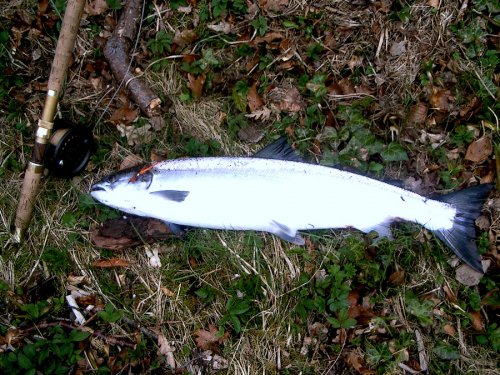The life cycle of some animals is truly unique; they occupy an ecological niche, which sets them apart from all others. The Atlantic salmon is especially remarkable. There are many prehistoric standing stones throughout Scotland with salmon carved upon them, marking the high regard primitive people had for the mighty fish. These hunter-gatherers would have noticed the annual patterns of ascending salmon. They would also have reaped the bounty of rich food, but none could have known the vast journeys that these remarkable fish had undertaken before arriving in the river.
Salmon live two lives. They are born in the higher parts of rivers, where they grow to maturity over two to three years as a wholly freshwater species. Then they become ready for a transformation as they swim downstream into the sea to become marine fish. The young salmon - called smolts - undertake a great journey to the rich feeding grounds of the North Atlantic off Greenland. Their food in the sea consists mainly of small fish species and crustaceans, sand eels, capelin and herring, and is supplemented by larger plankton. The abundance of food species allows the salmon to grow at a prodigious rate - they become sleek, powerful fish. As is the way with young adults, they start to feel the urge to reproduce. The instinct to return to spawn starts in some fish after a single winter in the sea. The returning salmon are called 'grilse' ('one-sea-winter' salmon). For others, it may take two or more years before they return.
Salmon also pick up a further description as 'spring', 'summer' or 'autumn' fish depending on the time of their arrival. Some Scottish rivers - the Tay, Spey and Tweed in particular - benefit from runs of fish from the start of each year. These early running salmon - called 'springers' - are superb fish. They are as fit as they can be - svelte and silver with each scale perfectly formed and aligned. An iridescent purplish-pink hue catches the light along their gleaming flanks. They are fin-perfect and powerful, fit for game angling, worthy to grace any table undoubtedly a wonderful prize. Increasingly, anglers opt to return their springers to encourage greater numbers of these lovely fish in the future.
Summer salmon come when rain breaks the summer droughts, often coinciding with runs of grilse. This is from June to August. Autumn fish come in September and October with some rivers, like the Tweed, having 'back-end' runs through November into December. It is true to say that salmon arrive at the mouths of our rivers throughout the whole of the year, but discernible 'runs' are seasonal peaks of numbers. Salmon are truly enigmatic. When they enter freshwater, it is almost invariably into the river where they were born. Research has shown that each river has its own 'odour' and this aids the salmon's homing instict. When they enter the river they cease feeding, and do not eat again until they return to salt water many months later. Not many of the post-spawning fish manage to return to the sea - there is a high mortality rate. For the few that do reach the lower river, it may be nearly a year before they slip back into the estuary. They have eaten nothing, relying on body stores developed during their feeding in the ocean. Little wonder that a much-reduced number of post -spawning fish, known as 'kelts', survive and even fewer beat the odds and return to the sea.
Atlantic salmon spawn in shallow nests called 'redds' scraped in the gravel in the closing weeks of the year. The female lays eggs (ova) amongst the gravel of the redd, while the male releases 'milt' over the eggs. Following fertilisation, the nest is re-covered with gravel and the ova mature for several weeks depending on temperature. A ten pound female salmon lays around 7000 eggs and as high a proportion as 90% of these hatch. Larger salmon may lay as many as 15,000 eggs. However, winter floods, interference by eels and birds and deposition of silt greatly influence the survival rate of fertilised ova. In March to April, the eggs hatch out into small fish-shaped creatures (called alevins), which retain some of the egg yolk-sac. At about four weeks, the yolk-sac is absorbed and the fry feed independently on microscopic particles. At this stage the greatest mortality occurs and around 90% of all fry fail to thrive.
Growth continues over one to two years until, in early summer, the largest parr take on silvery coloration and head towards the sea. This is normally two to three years after hatching. The 'smolts' are vulnerable to predation by fish-eating birds, but a proportion reach salt water, escape the seals and head off to the Northern Atlantic. Only 10% of smolts may return as adults, some coming back to the river of their birth after one full winter in the sea (grilse) and the remainder as multi-sea-winter salmon. Atlantic salmon numbers and runs seem to vary cyclically - although this is hugely inconsistent. The late twentieth century saw a decline in numbers throughout the whole range. Exactly why this happened has yet to be determined, although there is evidence that sea temperature increases influence growth and return rates. Many factors undoubtedly affect salmon numbers including: predation by seals and fish-eating birds, netting at sea, shore and in-river netting, changes to spawning areas, inappropriate fish-farming practices, weather patterns and angling pressure. Each of these factors plays a part. It is gratifying to see the strong conservation measures that anglers take to protect salmon. These include releasing some or all salmon caught, improving the river environment and limiting the ways in which salmon are fished for.
It is easy to be pessimistic about the future of salmon in our rapidly-changing world, but there are excellent demonstrations of genuine success. Worthy of note is the River Kelvin, flowing through the heart of Glasgow into the River Clyde. The Kelvin was heavily polluted and uncared for. But clearing out the obstacles, and ensuring that the water ran clear and unpolluted, the river was returned to a healthy state. Salmon were introduced and a spawning population established. You can now stand in central Glasgow, look over a bridge, and see salmon. If it can happen in the heart of a modern European city, there should be valid grounds for optimism for our wild rivers; but concerted and effective action must be taken by all parties at sea and at home.













